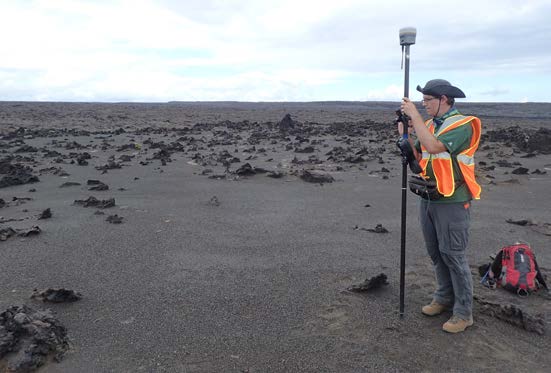2016 Cavanagh Travel Funds
Ethan Schaefer, sixth-year PTYS graduate student, had the opportunity to conduct field work in Hawaii with generous funding assistance from Mr. Dan Cavanagh. The goal of this research was to answer the question, “If all we can see in coarse, remotely-sensed data is the outline of a lava flow, what can we meaningfully infer, if anything, about that flow?” This question has direct application to bodies such as Io and Venus.
Over seven days (Sept. 5-11), Ethan and field assistant Sky Beard were able to visit all of the priority field sites and most of the secondary sites. Major accomplishments included:
• collecting high-resolution (~10 cm) differential GPS data along margins of a partially sand-covered flow through the Ka’u Desert (pictured). This flow yielded highly anomalous results in Ethan's 2014 pilot survey, so these new data will prove invaluable. Also collected were high-resolution differential GPS data across the top of this flow, allowing for a test of a working hypothesis that the shape of the margin is related to the surface roughness.
• visiting sites across Hawai’i Volcanoes National Park and further afield to test predictions of flow characteristics based on the team's working hypothesis and coarse remote imagery. Ethan's analysis of these data is not yet complete, but the preliminary results suggest that his working hypothesis does indeed provide insight into sub-meter flow characteristics even if the imagery is of far coarser resolution (>10-100 m). This technique holds substantial promise for leveraging coarse orbital imagery of lava flows on other planetary bodies—like Mars, the Moon, and Jupiter’s moon Io—to provide information at far finer scales that are otherwise accessible only by rovers.
• visiting an “anomalous” site surveyed by another researcher ~10 years ago and determining that the site is very likely not unusual, but merely misidentified. (Analysis is ongoing.) Ethan considers this finding to be encouraging, as the results from that other researcher would have otherwise been problematic for his working hypothesis.
• testing the limits of the working hypothesis by visiting a highly unusual site where so-called “toothpaste” lava was first identified. Ethan reports, "While analysis is ongoing, no other worker to date has collected the detailed margin data that we now have for this site, so the data themselves are a valuable contribution to our scientific understanding of the site."
 Ethan considers the field work a great success and plans to present the results at the American Geophysical Union meeting, December 2016.
Ethan considers the field work a great success and plans to present the results at the American Geophysical Union meeting, December 2016.

